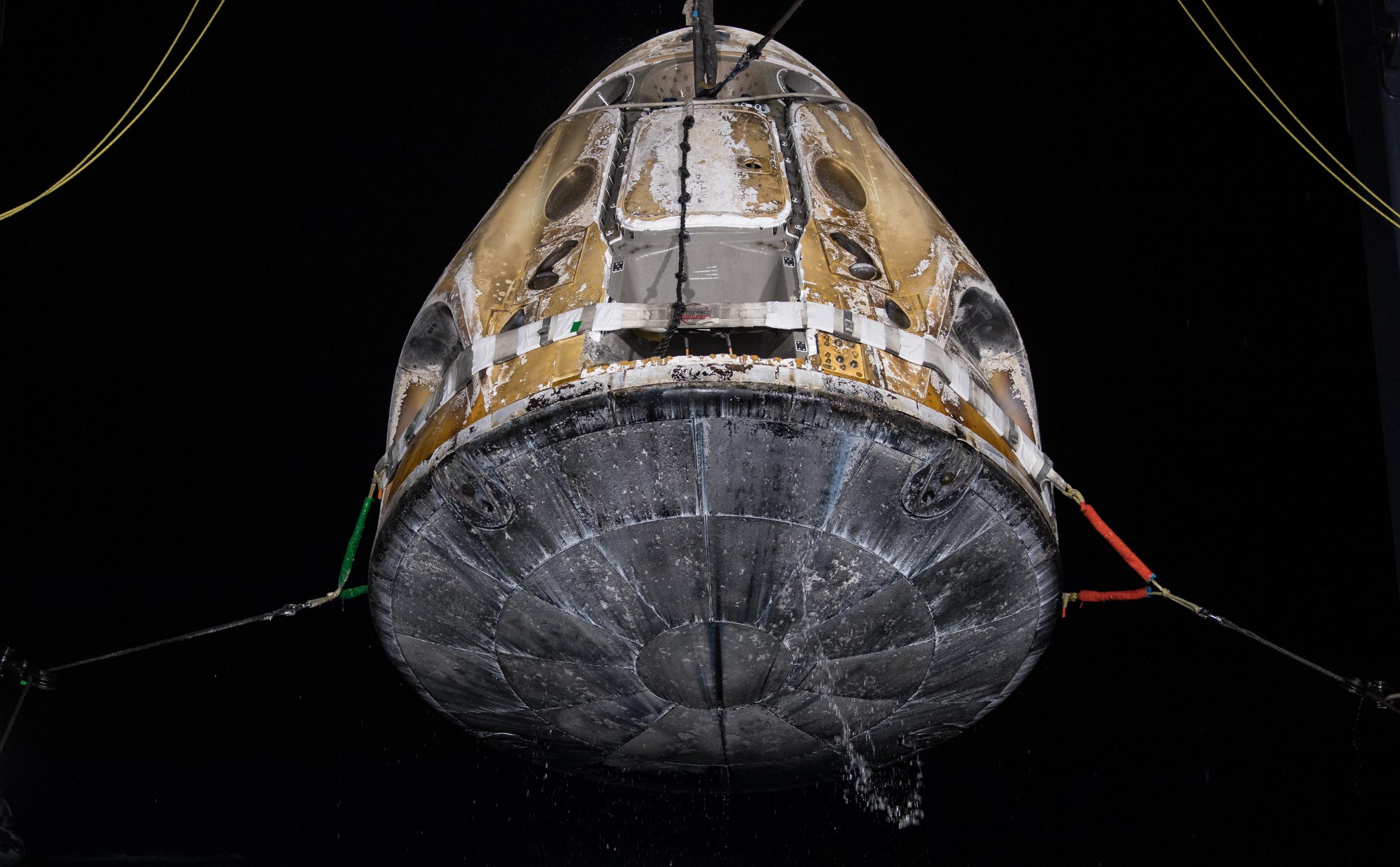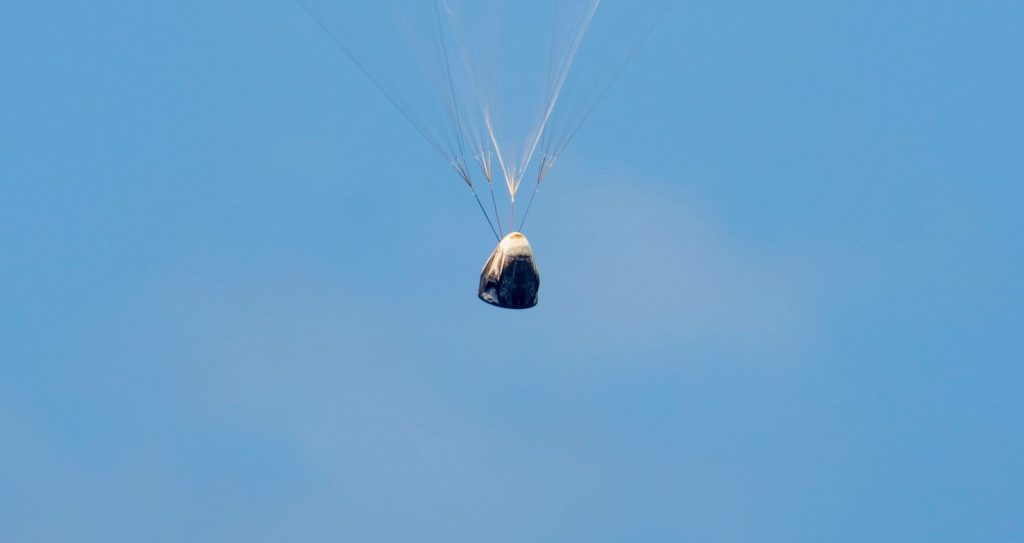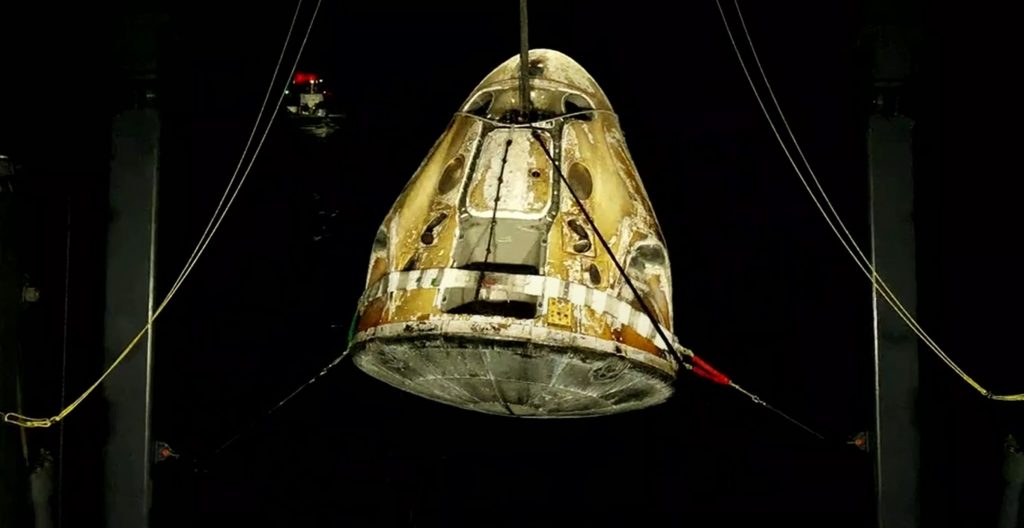

News
NASA denies SpaceX Crew Dragon propellant leak report, reveals unrelated heat shield defect
In a partial response to a report alleging evidence of several significant anomalies during a recent private astronaut launch that could affect a crew of NASA astronauts launched last month, the space agency has issued a statement denying those claims. However, the same statement simultaneously revealed that SpaceX recently discovered a different problem with a different Crew Dragon spacecraft component during ground testing.
On May 23rd, Space Explored published a report alleging that a SpaceX Crew Dragon spacecraft experienced major issues during Axiom-1, the company’s first all-private astronaut launch to the International Space Station (ISS). According to sourced info and a possible internal SpaceX memo, some of Dragon’s toxic propellant leaked during the 17-day flight, damaged or weakened parts of its heat shield, and “[caused] dangerously excessive wear upon reentry.” In general, the report appeared to be well-sourced and even alleged that NASA’s Engineering and Safety Center (NESC) had opened an investigation. Additionally, when approached for comment, neither NASA nor SpaceX were initially willing to speak on the record, which also meant that neither denied the accusations.
A day later, NASA provided an official statement to Space Explored explicitly denying that there has been any propellant leak, heat shield contamination, or excessive heat shield wear on any of “Dragon’s recent crew reentries.”
NASA also dismissed concerns about the reuse of a previously-flown Cargo Dragon 2 heat shield structure on Crew-4, which launched just two days after Axiom-1’s recovery and is scheduled to spend four to five more months in orbit. It also noted that the reuse of Dragon’s heat shield tiles – the structures that take the brunt of most reentry heating and are immersed in salt water after every mission – is extremely limited and has only been attempted on occasional Cargo Dragon missions.
Simultaneously, NASA revealed that “a new heat shield composite structure intended for flight on Crew-5 did not pass an acceptance test” at SpaceX’s Hawthorne, California Dragon factory. The unrelated test failure was blamed on a manufacturing defect and NASA betrayed no sign of serious concern in its statement, suggesting that the problem may be less serious than it sounds. In response, NASA says SpaceX will simply use a different heat shield composite structure for Crew-5, which is scheduled to launch no earlier than (NET) September 2022.
The data associated with Dragon’s recent crew reentries was normal – the system performed as designed without dispute. There has not been a hypergol leak during the return of a crewed Dragon mission nor any contamination with the heat shield causing excessive wear. SpaceX and NASA perform a full engineering review of the heat shield’s thermal protection system following each return, including prior to the launch of the Crew-4 mission currently at the International Space Station. The heat shield composite structure (structure below the tile) was re-flown per normal planning and refurbishment processes. The thermal protection system on the primary heat shield for Crew-4 was new, as it has been for all human spaceflight missions. SpaceX has only demonstrated reuse of selected PICA (Phenolic-Impregnated Carbon Ablator) tiles, which is a lightweight material designed to withstand high temperatures, as part of the heat shield on cargo flights.
NASA and SpaceX are currently in the process of determining hardware allocation for the agency’s upcoming SpaceX Crew-5 mission, including the Dragon heat shield. SpaceX has a rigorous testing process to put every component and system through its paces to ensure safety and reliability. In early May, a new heat shield composite structure intended for flight on Crew-5 did not pass an acceptance test. The test did its job and found a manufacturing defect. NASA and SpaceX will use another heat shield for the flight that will undergo the same rigorous testing prior to flight.
Crew safety remains the top priority for both NASA and SpaceX and we continue to target September 2022 for launch of Crew-5.
NASA – May 24th, 2022
Some oddities do remain. While NASA’s explicit refutation should be taken as the definitive final word on the matter, it’s still very unusual that NASA and SpaceX refused or were unable to quickly and publicly deny the claims within a few hours of being asked. That could simply be a consequence of NASA and SpaceX’s poor internal and external communication or both parties’ love for withholding information from taxpayers about systems and technologies that those same taxpayers have paid for.


On the opposite hand, after Crew Dragon’s Demo-2 run-in with greater-than-expected heat shield wear in 2020, it’s almost impossible to imagine that NASA and SpaceX would have proceeded with Crew-4’s launch two days after Axiom-1’s recovery without confidently verifying that heat shield erosion was within normal bounds. SpaceX’s upgraded Phenolic-Impregnated Carbon Ablator (PICA-X) Dragon heat shield tiles are reportedly designed to erode [PDF] less than a centimeter of their circa-2017 ~7.5 cm (3 in) thickness after each reentry. Musk has gone even further, stating in 2012 that “[PICA-X] can potentially be used hundreds of times for Earth orbit re-entry with only minor degradation each time.” If true, it would be extremely difficult for even a brisk post-flight inspection of Axiom-1’s Dragon capsule to miss what Space Explored described as “dangerously excessive wear.”
In theory, during recovery, even a minute propellant leak should have also been immediately detected by SpaceX’s recovery team, as the very first part of the hands-on process involves a small team with gas masks and detectors approaching the floating capsule to ensure that it’s safe for others to approach. Crew Dragon’s liquid monomethylhydrazine (MMH) fuel and dinitrogen tetroxide (NTO) oxidizer are highly toxic in small quantities and MMH is a known carcinogen.
All told, news of a potential propellant leak and anomalous heat shield performance appears to have been a false alarm, although – coincidentally or not – a seemingly minor anomaly with an unflown Crew Dragon heat shield structure did occur earlier this month. Despite that anomaly, Crew-4 and Crew-5 are otherwise proceeding nominally and NASA appears to be content with Crew Dragon’s performance during several recent launches and recoveries.
Elon Musk
Tesla Supercharger Diner food menu gets a sneak peek as construction closes out
What are you ordering at the Tesla Diner?

The Tesla Supercharger Diner in Los Angeles is nearing completion as construction appears to be winding down significantly. However, the more minor details, such as what the company will serve at its 50s-style diner for food, are starting to be revealed.
Tesla’s Supercharger Diner is set to open soon, seven years after CEO Elon Musk first drafted the idea in a post on X in 2018. Musk has largely come through on most of what he envisioned for the project: the diner, the massive movie screens, and the intended vibe are all present, thanks to the aerial and ground footage shared on social media.
We already know the Diner will be open 24/7, based on decals placed on the front door of the restaurant that were shared earlier this week. We assume that Tesla Optimus will come into play for these long and uninterrupted hours.
The Tesla Diner is basically finished—here’s what it looks like
As far as the food, Tesla does have an email also printed on the front door of the Diner, but we did not receive any response back (yet) about what cuisine it will be offering. We figured it would be nothing fancy and it would be typical diner staples: burgers, fries, wings, milkshakes, etc.
According to pictures taken by @Tesla_lighting_, which were shared by Not a Tesla App, the food will be just that: quick and affordable meals that diners do well. It’s nothing crazy, just typical staples you’d find at any diner, just with a Tesla twist:
Tesla Diner food:
• Burgers
• Fries
• Chicken Wings
• Hot Dogs
• Hand-spun milkshakes
• And more https://t.co/kzFf20YZQq pic.twitter.com/aRv02TzouY— Sawyer Merritt (@SawyerMerritt) July 17, 2025
As the food menu is finalized, we will be sure to share any details Tesla provides, including a full list of what will be served and its prices.
Additionally, the entire property appears to be nearing its final construction stages, and it seems it may even be nearing completion. The movie screens are already up and showing videos of things like SpaceX launches.
There are many cars already using the Superchargers at the restaurant, and employees inside the facility look to be putting the finishing touches on the interior.
🚨 Boots on the ground at the Tesla Diner:
— TESLARATI (@Teslarati) July 17, 2025
It’s almost reminiscent of a Tesla version of a Buc-ee’s, a southern staple convenience store that offers much more than a traditional gas station. Of course, Tesla’s version is futuristic and more catered to the company’s image, but the idea is the same.
It’s a one-stop shop for anything you’d need to recharge as a Tesla owner. Los Angeles building permits have not yet revealed the date for the restaurant’s initial operation, but Tesla may have its eye on a target date that will likely be announced during next week’s Earnings Call.
News
Tesla’s longer Model Y did not scale back requests for this vehicle type from fans
Tesla fans are happy with the new Model Y, but they’re still vocal about the need for something else.

Tesla launched a slightly longer version of the Model Y all-electric crossover in China, and with it being extremely likely that the vehicle will make its way to other markets, including the United States, fans are still looking for something more.
The new Model Y L in China boasts a slightly larger wheelbase than its original version, giving slightly more interior room with a sixth seat, thanks to a third row.
Tesla exec hints at useful and potentially killer Model Y L feature
Tesla has said throughout the past year that it would focus on developing its affordable, compact models, which were set to begin production in the first half of the year. The company has not indicated whether it met that timeline or not, but many are hoping to see unveilings of those designs potentially during the Q3 earnings call.
However, the modifications to the Model Y, which have not yet been officially announced for any markets outside of China, still don’t seem to be what owners and fans are looking forward to. Instead, they are hoping for something larger.
A few months ago, I reported on the overall consensus within the Tesla community that the company needs a full-size SUV, minivan, or even a cargo van that would be ideal for camping or business use.
Tesla is missing one type of vehicle in its lineup and fans want it fast
That mentality still seems very present amongst fans and owners, who state that a full-size SUV with enough seating for a larger family, more capability in terms of cargo space for camping or business operation, and something to compete with gas cars like the Chevrolet Tahoe, Ford Expedition, or electric ones like the Volkswagen ID.BUZZ.
We asked the question on X, and Tesla fans were nearly unanimously in support of a larger SUV or minivan-type vehicle for the company’s lineup:
🚨 More and more people are *still* saying that, despite this new, longer Model Y, Tesla still needs a true three-row SUV
Do you agree? https://t.co/QmbRDcCE08 pic.twitter.com/p6m5zB4sDZ
— TESLARATI (@Teslarati) July 16, 2025
Here’s what some of the respondents said:
100% agree, we need a larger vehicle.
Our model Y is quickly getting too small for our family of 5 as the kids grow. A slightly longer Y with an extra seat is nice but it’s not enough if you’re looking to take it on road trips/vacations/ kids sports gear etc.
Unfortunately we…
— Anthony Hunter (@_LiarsDice_) July 17, 2025
Had to buy a Kia Carnival Hybrid because Tesla doesn’t have a true 3 row vehicle with proper space and respectable range. pic.twitter.com/pzwFyHU8Gi
— Neil, like the astronaut (@Neileeyo) July 17, 2025
Agreed! I’m not sure who created this but I liked it enough to save it. pic.twitter.com/Sof5nMehjS
— 🦉Wise Words of Wisdom – Inspirational Quotes (IQ) (@WiseWordsIQ) July 16, 2025
Tesla is certainly aware that many of its owners would like the company to develop something larger that competes with the large SUVs on the market.
However, it has not stated that anything like that is in the current plans for future vehicles, as it has made a concerted effort to develop Robotaxi alongside the affordable, compact models that it claims are in development.
It has already unveiled the Robovan, a people-mover that can seat up to 20 passengers in a lounge-like interior.
The Robovan will be completely driverless, so it’s unlikely we will see it before the release of a fully autonomous Full Self-Driving suite from Tesla.
Energy
Tesla launches first Virtual Power Plant in UK – get paid to use solar
Tesla has launched its first-ever Virtual Power Plant program in the United Kingdom.

Tesla has launched its first-ever Virtual Power Plant program in the United Kingdom. This feature enables users of solar panels and energy storage systems to sell their excess energy back to the grid.
Tesla is utilizing Octopus Energy, a British renewable energy company that operates in multiple markets, including the UK, France, Germany, Italy, Spain, Australia, Japan, New Zealand, and the United States, as the provider for the VPP launch in the region.
The company states that those who enroll in the program can earn up to £300 per month.
Tesla has operated several VPP programs worldwide, most notably in California, Texas, Connecticut, and the U.S. territory of Puerto Rico. This is not the first time Tesla has operated a VPP outside the United States, as there are programs in Australia, Japan, and New Zealand.
This is its first in the UK:
Our first VPP in the UK
You can get paid to share your energy – store excess energy in your Powerwall & sell it back to the grid
You’re making £££ and the community is powered by clean energy
Win-win pic.twitter.com/evhMtJpgy1
— Tesla UK (@tesla_uk) July 17, 2025
Tesla is not the only company that is working with Octopus Energy in the UK for the VPP, as it joins SolarEdge, GivEnergy, and Enphase as other companies that utilize the Octopus platform for their project operations.
It has been six years since Tesla launched its first VPP, as it started its first in Australia back in 2019. In 2024, Tesla paid out over $10 million to those participating in the program.
Participating in the VPP program that Tesla offers not only provides enrolled individuals with the opportunity to earn money, but it also contributes to grid stabilization by supporting local energy grids.
-

 Elon Musk1 day ago
Elon Musk1 day agoWaymo responds to Tesla’s Robotaxi expansion in Austin with bold statement
-

 News1 day ago
News1 day agoTesla exec hints at useful and potentially killer Model Y L feature
-

 Elon Musk2 days ago
Elon Musk2 days agoElon Musk reveals SpaceX’s target for Starship’s 10th launch
-

 Elon Musk3 days ago
Elon Musk3 days agoTesla ups Robotaxi fare price to another comical figure with service area expansion
-

 News1 day ago
News1 day agoTesla’s longer Model Y did not scale back requests for this vehicle type from fans
-

 News1 day ago
News1 day ago“Worthy of respect:” Six-seat Model Y L acknowledged by Tesla China’s biggest rivals
-

 News2 days ago
News2 days agoFirst glimpse of Tesla Model Y with six seats and extended wheelbase
-

 Elon Musk2 days ago
Elon Musk2 days agoElon Musk confirms Tesla is already rolling out a new feature for in-car Grok
















